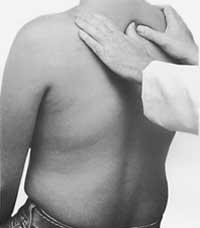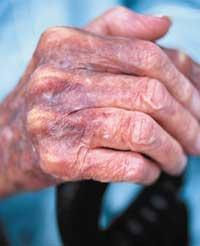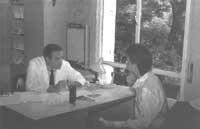Neck pain
2004/03/01 Agirre, Jabier - Medikua eta OEEko kidea Iturria: Elhuyar aldizkaria
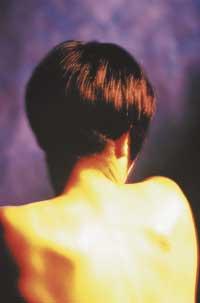
Cervicalgia is pain that appears on the back or sides of the neck. The cervical spine has 7 vertebrae that form a slightly inclined forward arch. Cervical vertebrae have important functions: to facilitate the movements of the neck, to maintain the weight of the head and, above all, to protect the trajectory of the spinal cord. When the seven necklaces work properly, the balance of the head stays well. To know if this is so, a simple test can be done: looking forward, we will place a cardboard between the teeth; if that cardboard is kept completely in horizontal position, there is no problem in the cervical or balance position of the head.
This balance position is very important because if you lose the balance, the muscles begin to work to recover the lost position. And that is why neck pains are multiplying caused by remaining in inadequate and violated positions for a long time.
With age, this balance is also lost due to degenerative changes in the cervical area. This is the most common cause of pain in older people, but there are also other causes: some inadequate movement, a work or circulation accident... the origin of pain can be muscle or even an underlying hernia.
More frequent cases
Torticolia
In this case neck pain suddenly appears, due to muscle contracture. There are no suspicions of reason or apparent causes. After a few days the pain disappears with the anti-contracture treatment, but meanwhile the pain and the inability to perform certain movements make everyday tasks impossible.
Neck punishment syndrome
is very common in traffic accidents, for example. A strong blow, like in a car, makes the neck move forward and back. Depending on the nature of the shock, the connectors can break, stretch the muscles, move the site vertebrae, damage the intervertebral discs and even cause a hernia.
Any movement of the neck, however small, produces a lot of pain. Movements are very limited. But the most dangerous complication is chronic pain. Therefore, it is advisable that the doctor perform a review to check if the aforementioned injuries have occurred. If treatment (usually anti-inflammatory and analgesic) is done rigorously, the pain goes away in 15 days.
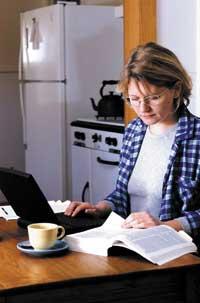
Chronic Cervicalgia It
appears more in women, since in the day to day they have their neck for a long time in inadequate and forced positions such as putting data on the computer, working at home or sewing. Maintaining these inadequate postures for long hours produces painful contractures.
Arthrosis of the cervical
spine With age, arthrosis is becoming more frequent. The most important symptoms are neck and shoulder pain, stiffness or decreased movements. If osteoarthritis continues, dizziness can occur, as the vertebral arteries suffer the consequences of degeneration. Tingling in hands, fingers, shoulders, or the entire arm is typical (the arm feels asleep).
Disc herniation The
cartilage of the intervertebral disc that by trauma, excess weight or simple wear cushions or cushions the movements of the vertebrae deforms in the long run. The disc comes out of its “normal” place and moves, and when in this new way it compresses or traps a nervous end pain appears.
Very severe pain near the spine. If any nerve root has become crushed, the pain extends to the arm. Altered sensitivity, loss of strength and reflexes. The patient feels tingling, stiffness, and numbness. Pain gets worse with movements, coughing, and sneezing.
It is
admitted that stress and anxiety cause cervicalgias.
How is the diagnosis performed?
The first step is to analyze symptoms and signs: perform a complete physical examination of the patient to assess the presence of muscle contractures and mobility in the upper extremities. Once this is done, a simple x-ray of the neck (both anterior and lateral) is sufficient to determine the cause of the process.
However, when diagnosis is unclear or symptoms do not go away with conventional measurements, complex radiological studies such as computer axial tomography (CT) or magnetic resonance imaging (EMN) may be necessary.
Lesions may also appear in patients who have not had any symptoms. In fact, there is no correlation between clinical symptoms and radiological findings: people with great pain and very limited cervical mobility may maintain the bone structure in perfect condition without alterations. In these cases it is necessary to think that the problem can be muscular and focus on looking for those studies: overexertion, inadequate postures, too many tensions at work, stress, etc.
What are the most appropriate treatment routes?
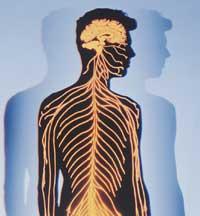
Obviously, the treatment of cervicalgia or cervical pain will depend on the origin of the pain.
- Muscle contractures disappear in a few days: rest, warmth and muscle relaxants are ideal to increase muscle strength and recover and increase mobility and flexibility. Proper postures and postures, sleeping with a pillow (or without pillows) that suits the anatomy of the neck, relaxation techniques and massages are appropriate measures. Swimming is also a very suitable exercise, but not in chest style, but dorsal or crowl, to relax the muscles of the neck.
- Much is discussed about neck tractions (stretching). Some are very favorable and others, on the other hand, are totally against. They can be used when there is no neurological injury, but never when there is suspected hernia.
- The necklaces were very fashionable a few years ago. Necklaces can be soft or hard. Soft ones are suitable against pain, especially at night, as they reduce mobility to 75%. However, strong necks are only recommended for severe and acute injuries (hernias, severe trauma, or cervical sprains). They limit neck mobility to 15% and weaken muscles with prolonged use. Therefore, they should always be used under a medical prescription and only within the period indicated by it.
- Pain relievers, nonsteroidal anti-inflammatory drugs, and muscle relaxants can be of great help in treating cervical pain. But, of course, always by medical prescription.
- What about surgery? It should always be considered as the last remedy. Only 5% of patients with herniated discs go through the operating room, as unnecessary intervention can cause worsening of symptoms. Surgery is recommended when the muscles that control the compressed nerves have lost a lot of strength or the spinal cord has been affected. Most hernias on the disc heal themselves or with other measures is a matter of time.
Working for hours in front of the computer “contracts” the vertebrae of the neck and causes stiffness of the neck. It is best not to look at the keyboard while typing, keep the screen at eye level and place the feet on a stand, as the neck adopts the most appropriate posture.
When reading, it is best to put the book, magazine or newspaper on a lectern. Since that is normally not done by anyone, it is convenient that at least what we are reading is as high as possible so that it approaches the level of the eyes.
The position of cooking or cleaning containers is also very important. It is not necessary to bend too much the head (this is what happens when the fire or sink are very low), since the cervical are loaded in this position.
Special attention should be paid to ironing. To avoid pain it is convenient to keep one foot above, for example on a support, and as soon as the leg feels tired, alternate and carry the other foot over the support.
When lifting the weights from the ground, lift the load with the strength of the legs keeping the back straight. Slowly gain weight, stretching the limbs slowly. And to carry the weight from side to side, help us with the body, like the waist, approaching the load to the trunk so as not to carry it alone hanging from the arms.
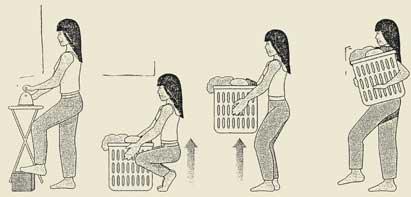

Gai honi buruzko eduki gehiago
Elhuyarrek garatutako teknologia



